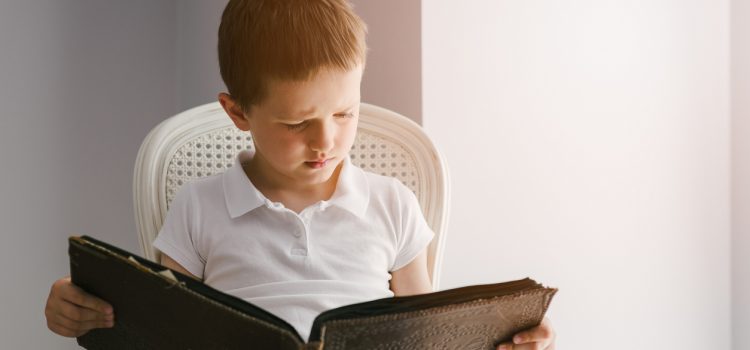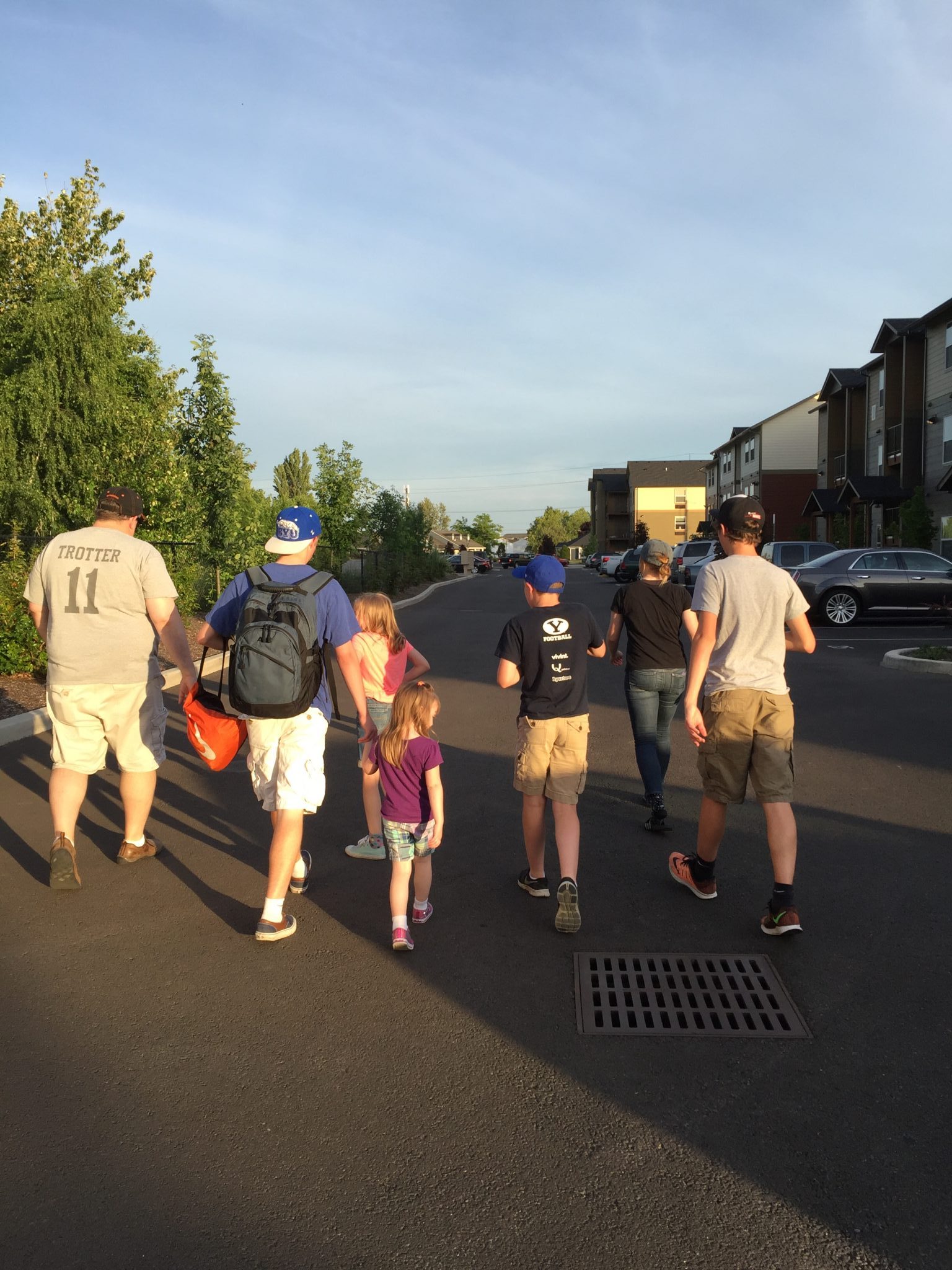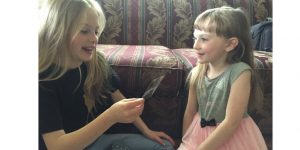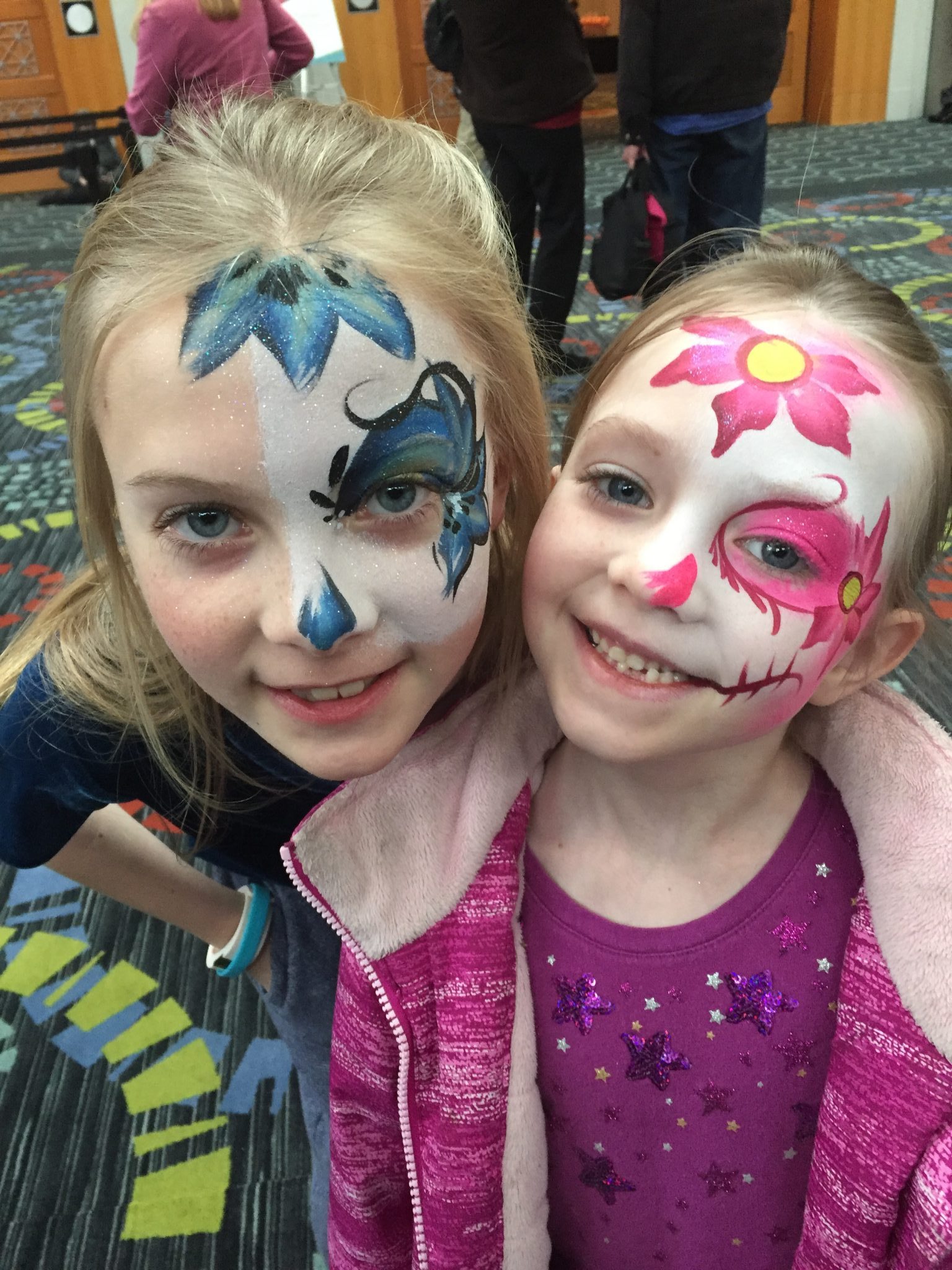
When we hear the words family history or even family storytelling our minds often picture a little old gray-haired lady in a jogging suit and tennis shoes sitting at a computer typing as quickly as her fingers can move. But I’m here to tell you that image is quickly changing. I have even seen a huge shift in my own home in just the last three months. In fact, I am quickly discovering that family history is for kids. And not only is it for kids, but they hold the keys to open it up to the world in a way those of us who are lovers of family history and family stories can only dream of.

Know your why’s
Aside from how-to do family history with kids, there are also the why’s. There are two big ones for me:
- There is a spirit of love and joy in your home when talking about family history and family stories. That’s a great reason in and of itself.
- When kids know their family history they are stronger, happier, more resilient and more confident. And that’s a fact. Read my article about it here.
Family stories for young & old
I have six children and I often break them into two parts – the oldest three and the youngest three. The oldest three are over age 18 and aren’t living at home right now. The change of having six in our home to three happened all too quickly. This fall it felt super strange to only have three children, ages six to fifteen, living in our house.
I found that I had spent so much time focusing on those oldest three through their teenage years and sending them off to college, marriage and service experiences that it felt as though I had just been bringing the youngest three along for the ride. In other words, I had neglected teaching them about our family stories and they hadn’t felt that joy, resilience and confidence that comes with those stories.
Making it fun
I decided that we needed to change and bring back our family narrative, reminding them who they are and where they came from. It was time to step up our family stories game, and fast. I found they didn’t remember the things I thought I was teaching all six of them because they were too little when we had emphasized it with the older children. And when I say “I” I really mean “we.” My husband is the ultimate master of bringing in family stories to our family narrative.
So how, you ask, do we get our kids to jump on the family history train? Here are five ways that I, (along with advice from the experts), have found that work for families of all shapes and sizes.
Make it a game
Set goals and offering rewards
Watch some good old-fashioned television together
Speak their language
Make family history and family storytelling a part of your family culture
1. Make it a game
There are many different types of family history/story games out there. Some people are also creative and make up their own. My mom is one of those. When we were young she created a family history jeopardy game that we played at family reunions and family get-togethers.
Now, some Brigham Young University students have come up with a free trivia game called Geneopardy that pulls questions from your own FamilySearch account, and it is loads of fun. I played it on my own and then included my kids. Click here to play with your family.
After RootsTech’s Family Discovery Day, my children were pretty pumped about family history and learning about our family stories. We decided we needed to keep the momentum and find some ways to keep the storytelling talk alive.

I have to admit, one of my favorite family games we just incorporated is Pando. In the game we gather around and the parents pull questions from a box and the kids answer. The questions are about the parents’ lives – as a couple, as children, and about their ancestors. My husband brought it home after he saw it at RootsTech and we play it almost weekly. It is so much easier to tell those vital family stories when it is in the form of a game.
Motivated to learn
The first time we played, my six-year-old daughter lost big-time. She was not happy about it. Since that time, she will casually start a conversation with me or her dad. “Mom, tell me what you did when you were 11. What games did you play? Who were your friends?” To her dad: “Dad, what was your favorite food when you were little? How did you meet mom?”
I was delighted to share detailed accounts of stories she was carefully asking about and didn’t really understand where her questions were coming from. The next time we played Pando, it became clear.
“I’m ready to play,” she said with a huge grin. “I’ve been doing my homework!” Her dad and I laughed out loud because suddenly we knew the source of the questions and we didn’t care one bit. She was learning her family stories and family history on her own terms. And she’s six.
“A whole new world opening up”
Steve Rockwood, CEO of FamilySearch International, said he has great faith in the rising generation in all aspects, but most notably with family history. “For a long time we were focusing on the teenagers to get them excited, but now we are seeing a whole new world opening up with even younger children and our demographic is focusing on them,” he said. He sees that the opportunities for learning and growth are limitless for the younger generation, and I can see it in the eyes of my six-year-old.
We also love to play the Ungame, which is similar to Pando, but with more general questions that everyone can answer. There is no winner or loser with this one. This is a bit of a bonus with our competitive family – less tears and more fun.
2. Set goals and offer rewards
This idea can come in many different forms. The first year I attended RootsTech as a newspaper reporter we elected to not bring our kids to the Family Discovery Day Saturday. I was working and the logistics of getting our kids there seemed nightmarish. Well, that was a big mistake. The pearls of wisdom my children could glean from that day were well worth other practicalities.
After that, we set a goal to always bring them every year. It is now a family tradition for the kids to join my husband and I. It is a goal well worth keeping and the rewards are still paying off, really on a daily basis. Every year my children have met someone that inspired them to be better and to do better, and I have watched that happen. Another side reward has been getting a little staycation in a hotel in Salt Lake City for one night.

A family history rite of passage
There are other goals and rewards to consider too. With the younger three, we have challenged them to understand how to find family history names by the time they turn 12. The reward? A special night out with mom and dad and any older siblings they want to invite. During the month of March my daughter Julia was set to turn 12. She spent countless hours by her father’s side learning how to find names all on her own.
It was a struggle some days and some tears were shed, but there was a spirit of joy that went along with her journey. And then the day she figured it out? Magic! There were actual squeals of joy and jumping up and down in front of her computer as she made the discovery.
Kids can become the teachers
My husband has challenged my 15-year-old son to teach others how to use FamilySearch and Ancestry. It took some work, but he is a qualified teacher now. He cruises around family history sites with confidence and love. He’s 15, so he’s not spending every waking moment doing it, but he’s well on his way.
Also, FamilySearch has just introduced a whole new section on their website called “in-home activities.” There are several ideas there that go along with the idea of setting goals and offering rewards. Things like time capsules, all about me boxes, having a digital recording evening and discovering facts about the place you were born can give children incentive and awards quickly. For more details, click here.
Related: Children, technology, and family stories = Magic
3. Watch some good old-fashioned television together.
We have found a couple of great family history television shows that spark family storytelling. Our current favorite is Relative Race on BYUtv. The show follows four teams of two around the United States as they discover relatives and unlock parts of their past, connecting their family trees. There is a cash prize at the end, but the journey of the teams pulls at the heart strings on a weekly basis. Our family simply adores this show.
As we watch these families connect with each other it almost always proves to be a catalyst for conversations about our own family history. It might be a town they are visiting that we have a connection to, a way family members meet or even the conversations teammates have while traveling in the cars. Watching the show has become one of my favorite parts of the week.

We have also watched some Finding Your Roots with Henry Louis Gates and Who Do You Think You Are where celebrities trace their family history and learn family stories. Watching that show together also spurs great conversation our own family history. It seems to strike more of a chord with the teenager/young adult crowd. For some reason watching others make family discoveries makes us want to do it too, right?
Related: What story will your DNA tell?
4. Speak their language.
I have spent a lot of wasted days, weeks, months, even years trying to get my kids to conform to things my way. It has taken a lot of children and a lot of frustration for me to learn to speak their language. For example, at RootsTech this year my six-year-old wanted her face painted. The theme of the family day was Mexican culture because of the fabulous family movie Coco. She loves the movie and wanted her face like Coco.
The line was long, I didn’t want to wait – there was so much to see and do. But she was unhappy all day until we finally got her face painted, then voila – attitude change. For her, the face painting that day was her way to connect to family history. The same was true with my 12-year-old and the Relative Race booth. Once I learned to speak their language they learned, they shared, and we had a great day.
Related: Coco movie reminds us what is truly important – family – past, present and future

Let your kids do it their way
This is true for much of our family history. Let your kids do it their way. Do they want to use social media to share the family photos? Learn about social media and let them show you! Do they want to use an app instead of computer software? Let them lead the way on that. There is so much our kids can teach us!
When my daughter was trying to teach me how to edit videos for a family history project it went so much better when I let her be in the driver’s seat because she knew her stuff! Once I slid over and let her guide me there was a special feeling in the room and we accomplished so much more.
Related: Animoto and Adobe Creative Cloud Express for Videos – 10 Ideas
5. Make family history and family storytelling part of your culture.
This last and final idea, may be the most important. Our family does not walk around with audio tapes or journals recording every morsel of our family life. In fact, I know we don’t do that part of it enough. But we do try really hard to express the importance of knowing where you came from, why, and where you are going. We do not get through many dinner time table talks without one of our children asking to hear a story from our youth.
My dad was probably the biggest pro at sharing about his childhood with me and my kids. I can picture exactly what his Texas hometown was like because of the details he used to describe it. My mom has done this too. I think I could draw a map of her tiny Northern California town by the way she described it to me. I was raised with the culture and so it makes it easier to share that culture with my own kids.
Keep it simple, silly!
There are different activities that can involve the whole family even if you don’t all live together or have young ones. Working toward a common goal not only unites your family, but accomplishes something. It can be as simple as gathering flowers to take to the graves on Memorial Day, to completing a large family history book.
I greatly admired LDS Church leader Dallin H. Oaks’ stack of family history books he showed the audience at RootsTech this year. The books were both big and small, but they were bound books about family members that had gone before. A project like that takes time and work, but many hands make light work. A project like that can be worked on together.
Do it for the children
In the Steve Rockwood interview I mentioned before, he talked about grandparents and grandchildren working together on projects and how those children bring the rest of the family along. “It’s amazing what people will do in the name of their grandson or granddaughter,” he said. When he told me that a smile swept across my face – true words right there. Anytime any of my children sincerely ask their grandparents for ANYTHING it would seem they would walk barefoot over hot rocks to get it for them. Why would it be any different with family history?
The video below puts it perfectly.
Related: Teach your children to remember
Make History Personal
We often try tying together historical events with family events. My husband’s grandfather fought in World War II. We have spent long hours detailing the events of World War II with my 15-year-old son, describing where he was in the war. The same with the Great Depression. Rockwood mentioned this idea. “Family history is only going to enhance and grow regular history,” he said.

Related: What’s the history in your family history?
I also find that youth of today want to do something with the stories we tell. They want to digitize, record podcasts, make videos, and bring it to action. Brandon Stanton, of Humans of New York fame expressed the same energy when he said he didn’t want to wait around for things to happen in his life – he was going to go forward with action.
I see that happening on the daily. My family does not have it all together, not by a long shot. But we are trying bit-by-bit to be a little better each day. I need to be better at journaling and oral history, but that will come. Till then, I have to take happiness in the small victories with teaching my children.
“It’s about discovery…”
So is family history for kids? You bet. And it’s not just about names and dates. It’s about discovery, feeling the spirit of the work, and the joy that unfolds as your family learns about each other. When things are tough in our life, we connect to our powerful roots through stories. If we have a family member that we have come to know through family storytelling who has survived a hardship, we know we can too. On hard days, I often think of those ancestors and feel them near. I am absolutely certain my children do too. I feel that strength come to them. As a parent in this day, I need all the help I can get!

Rachel J. Trotter is a senior writer/editor at Evalogue.Life – Tell Your Story. She tells people’s stories and shares hers to encourage others and especially loves family storytelling. A graduate of Weber State University, Rachel has had articles featured on LDSLiving.com and Mormon.org. She and her husband, Mat, have six children and live on the East Bench in Ogden, Utah.
Disclaimer: This page contains affiliate links which means if you purchase some of the products we mention by using our links, we make a commission. Be assured that I’m only sharing the methods I actually use, but I do appreciate when you buy with my links because it helps fund articles like this one.
Printable Question Book

Free download makes a great gift for parents or grandparents.







Pingback: RootsTech 2019: An Event Full of Wow. Read my top 7 Takeaways - Tell Your Story with Evalogue.Life
Pingback: How to Teach Your Children to Truly Remember Who They Are | Meridian Magazine
Pingback: Remember who you are. Help your kids put down their phones and remember.
Pingback: Dad tell me your story. You may be asking, "How?" We have some ideas.